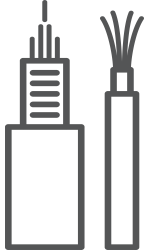Scope and types of fiber optic cable

Nowadays, fiber optic products have replaced many other types of cables. This is mainly due to the lower manufacturing cost of the material. The raw material for the creation of the product is plastic or glass, and in other cases copper, which has a higher price. In addition, the weight and overall dimensions of glass or plastic cables are lower. These facts shape the popularity of optical products.
General characteristics of fiber optic lines
In addition to the above-described parameters in low cost, low specific weight and dimensions, optical fiber has several more positive aspects. The signals passing through the channels practically do not attenuate and are transmitted silently, which leads to a high throughput, that is, the indicators of receiving and transmitting a pulse increase. The information is transmitted in such a way that it is almost impossible to trace it, and the connection methods do not allow hacking the line with conventional methods.
The operation of optical wires excludes the occurrence of sparks, so they can be laid in rooms for any purpose. The connection to the source is made by galvanic method, so that the fiber-optic cable does not need to be grounded. The service life of the line of this type is also long and is 20-25 years, after which the conducting capacity is lost and the process of degradation begins. The connection of the points is carried out by means of welding or special couplings - splices.
Fiber Optic Cable Applications: General
Cables of this type are gradually replacing copper varieties from power and communication networks. Internet and telephone communications, cable television, restructuring and systematization of schemes for various purposes - this is not a complete list of areas where optical fiber can be used. In addition, a cable of such a plan is used to create lighting lines, allows you to decorate buildings with illuminated signs, mock-ups and other illumination, and can be used as a power supply for sensors and other lighting devices.
Types and types of fiber optic cables
There are a lot of types of these communication devices, which determines the scope of their application. They differ in execution, characteristics and purpose. For example, a fiber-optic cable differs from others in its characteristics and can be used in different areas. By appointment, the channels are:
- distribution;
- self-supporting;
- suspended;
- underground;
- external and internal use.
In fact, the latter group includes all kinds of communication schemes. That is, products for external and internal use combine channels for laying in the ground, sewers and can be used as internal networks to supply a signal to the consumer. By design, fiber-optic cables are divided into single-mode and multi-mode (multi-mode). The latter are distinguished by lower cost, greater functionality and simple manufacturing technology. They are also widely used in high bandwidth and longer backbone networks. Singlemode cables have a very small core diameter, which results in a more complex manufacturing process.
Fiber optic cables have a quality standard that defines the structure and performance requirements of individual lines. All the main characteristics of networks and circuits of a similar design can be found on specialized portals that sell these products and create high-tech communication systems.


















